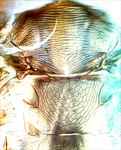Distinguishing features
Female macropterous. Body and legs brown, fore tarsi and apex of fore tibiae paler; antennal segment III yellow, usually only with apex brown, IV yellow in basal third, V–IX brown; fore wing weakly and variably shaded, with paler areas sub-basally and sub-apically; clavus and costal vein shaded. Head with postocular region shorter than eye length; distal maxillary palp segment subdivided. Antennae 9-segmented, III–IV with sensorium curving around apex, weakly sinuous and extending to basal half of segment, with weak discoidal internal markings. Mesonotum with 3 or 4 pairs of accessory setae medially. Metanotal reticles with rather weak internal dot-like markings (sometimes weakly linear markings). Abdominal tergite I transverse lines medially; trichobothria on X about as large as base of major setae on X. Sternites with 4 pairs of marginal setae and about 4 pairs of discal setae laterally, none medially on VII.
Male similar to female but smaller. Abdominal tergite I with two longitudinal ridges. Sternites with 1 or 2 pairs of discal setae laterally, apparently none on IX.
Related species
The genus Desmothrips is known only from Australia, with 18 described species (Pereyra & Mound, 2010). D. crespii is an unusual species within this genus because, like D. stepheni and also D. mendozai, it has the forewings more or less uniformly shaded without any discrete dark bands. There is some variation in structure between populations, in size, colour and form of the sculpture within the metanotal reticles, and this may indicate the existence of a suite of sibling species (Pereyra & Mound, 2010).
Biological data
Collected particularly from the flowers of various species of Acacia [Fabaceae], but also from the white flowers of a species of Hakea [Proteaceae].
Distribution data
Widespread across the northern part of the arid zone in Australia, between Mt Isa in Queensland and Tom Price in Western Australia.
Family name
AEOLOTHRIPIDAE
Species name
Desmothrips crespii Marullo
Original name and synonyms
Desmothrips crespii Marullo, 1995: 164
References
Marullo R (1995) Two new species of Aeolothripidae (Thysanoptera) from northern Australia. Redia 78: 163–171.
Pereyra V & Mound LA (2010) Phylogenetic relationships within the genus Desmothrips (Thysanoptera, Aeolothripidae), an Australian genus of facultative flower-living predators. Systematic Entomology 35: 306–317.




